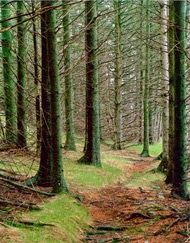 Eliot Porter is an
American photographer, best known for his photographs of nature. Eliot was born
December 6, 1901 and died November 2, 1990. He was given his first camera in
1911, when he was only 10 years old. He immediately took pictures of birds
around his house in Chicago, and over the summer at Great Spruce Head Island,
in Maine. Eliot was sent east for high school, and after that he enrolled for
Harvard. He graduated from Harvard in 1923 with a Bachelor of Science degree in
chemical engineering, and in 1929 he graduated with a medical degree. After
making a career as a biochemical researcher at Harvard, he could not let go of
his love for photography. Supported by his brother, a realist painter, and being
introduced to Ansel Adams and Alfred Stieglitz, famous nature photographers,
Eliot began taking pictures of New England landscape. Stieglitz offered to
exhibit some of Eliot’s photographs at An American Place, Stieglitz’s New York
City gallery. With Stieglitz’s interest, Eliot decided that photography would
be best for his career, and he quit his medical career. Eliot immediately
decided to stop shooting in black and white so he could capture the true effect
of nature in color.
Eliot Porter is an
American photographer, best known for his photographs of nature. Eliot was born
December 6, 1901 and died November 2, 1990. He was given his first camera in
1911, when he was only 10 years old. He immediately took pictures of birds
around his house in Chicago, and over the summer at Great Spruce Head Island,
in Maine. Eliot was sent east for high school, and after that he enrolled for
Harvard. He graduated from Harvard in 1923 with a Bachelor of Science degree in
chemical engineering, and in 1929 he graduated with a medical degree. After
making a career as a biochemical researcher at Harvard, he could not let go of
his love for photography. Supported by his brother, a realist painter, and being
introduced to Ansel Adams and Alfred Stieglitz, famous nature photographers,
Eliot began taking pictures of New England landscape. Stieglitz offered to
exhibit some of Eliot’s photographs at An American Place, Stieglitz’s New York
City gallery. With Stieglitz’s interest, Eliot decided that photography would
be best for his career, and he quit his medical career. Eliot immediately
decided to stop shooting in black and white so he could capture the true effect
of nature in color.
During Eliot’s career,
black and white photography was the standard and he had to fight other photographer’s
prejudices to prove that color photography was a good medium. Eliot used a dye
transfer process technique his entire photography career. This process required
making three printing matrices, on for each primary color. When placed one on
top of another the dye transfers from one sheet to another, creating an image
when finished. In 1962, Eliot Porter got
a major boost in popularity when his book called “In Wilderness Is the
Preservation of the World” was published. This book showcased many of Eliot’s color
photographs along with excerpts of Henry David Thoreau’s writings. This book
set new standards for nature photographers. The success of the book set Eliot’s
career on a lifelong path of creating color nature photos all over the world. He
traveled the world capturing culturally significant places such as Egypt,
China, Ancient Greek sites. He also captured unusual sites such as Baja
California, Antarctica, and Galapagos. He had a huge impact on photography
today because of his color photographs and because of the books he published. Eliot
Porter published 25 nature photography books, and was working on more when he
passed away in 1990.
Sources:
"Eliot
Porter." Wikipedia. Wikimedia Foundation, 22 Feb. 2014. Web. 07
Apr. 2014.
Rohrbach, John,
and Alonzo Sanchez. "Eliot Porter: About Eliot Porter." Eliot
Porter: About Eliot Porter.
Amon Carter Museum, n.d. Web. 11 Apr. 2014.
Image URL:



No comments:
Post a Comment